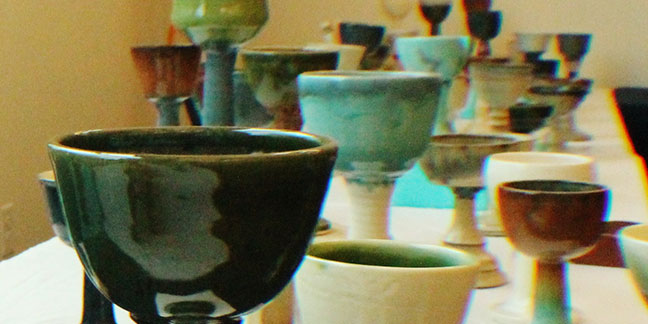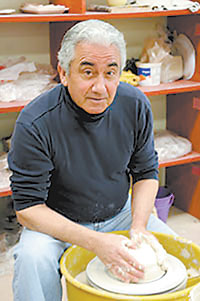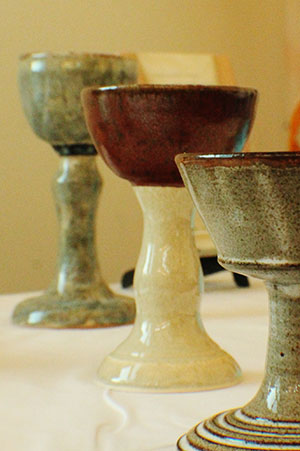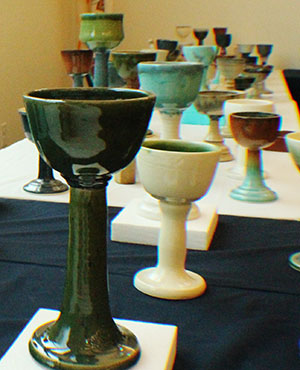‘Can you drink the cup?’
 KERNERSVILLE — A love of clay and his Catholic faith served as inspiration for local artist Peter Strafaci to create 100 unique, hand-thrown pottery chalices.
KERNERSVILLE — A love of clay and his Catholic faith served as inspiration for local artist Peter Strafaci to create 100 unique, hand-thrown pottery chalices.
His 2016 collection, the “One Hundred Chalices Exhibit,” has been displayed at parishes, Christian churches and faith-based conferences.
The chalices feature variations of colored glazes, and no two are the same. Chalices hold a special place in Christian worship, as Jesus offered the chalice to His disciples in the upper room during the Last Supper, just hours before His crucifixion.
Strafaci offers a presentation – “Can You Drink the Cup?” – for those interested. It is based on both a book he read with the same title by Father Henri Nouwen and on Matthew 20:20-23. In this Scripture passage, Jesus questions the sons of Zebedee: “Can you drink the cup that I am going to drink?”
“The cup that Jesus speaks about is neither a symbol of victory nor a symbol of death,” Strafaci explains. “It is a symbol of life, filled with sorrows and joys that we can hold, lift and drink as a blessing and a way to salvation.”
 Artist Peter Strafaci throws some pottery at his studio in this undated photo. (Photo provided)Strafaci says the chalices took about 10 months to create. He threw the stems and cups separately, in batches of 12 or 13 at a time. “They were created with very little mishap,” he recalls. “I sensed the Lord blessed this work, as I have been working with pottery for over 50 years.”
Artist Peter Strafaci throws some pottery at his studio in this undated photo. (Photo provided)Strafaci says the chalices took about 10 months to create. He threw the stems and cups separately, in batches of 12 or 13 at a time. “They were created with very little mishap,” he recalls. “I sensed the Lord blessed this work, as I have been working with pottery for over 50 years.”
He estimates it took at least 40 minutes to create each chalice on the potter’s wheel and additional time to glaze each one before firing it in the kiln.
Strafaci admits he did have one providential mishap when he was transporting the exhibit in 2016 that has reaped unforeseen spiritual benefits for his audience. A box of chalices was damaged, and four of the chalices used in the exhibit were broken.
“It dawned on me to take the four broken chalices and make them still part of the 100. This represents the brokenness in each of us,” he explains. “I’ve kept those four chalices to use them to illustrate this point.”
Strafaci says that for smaller groups he begins his presentation by inviting participants to select one chalice to take back to their seat to hold during the presentation for contemplation.
Reactions to the exhibit over the years have been very positive. Mary Martha Douglas, Women’s Bible study coordinator of St. Leo Church in Winston-Salem, helped bring the exhibit to the parish last February.
“I found your talk to be thought provoking, reflective, healing, comforting, inspiring and grounded in Scripture,” she wrote to Strafaci after his presentation.
“Ultimately, you left us with a message of hope and peace for which we are most grateful.”
Now that parishes are resuming normal activities in the wake of the pandemic, Strafaci hopes to share the exhibit with more people across the diocese.
“I’m not there to sell my pottery,” he emphasizes. “I just want to share the exhibit and encourage them with my talk if requested.”
— SueAnn Howell
 Host the exhibit
Host the exhibit
If your parish, group or ministry would like to host the “One Hundred Chalices Exhibit” (with or without the presentation), contact Peter Strafaci at This email address is being protected from spambots. You need JavaScript enabled to view it. or 336-402-8639.
Visit www.peterstrafaci.blogspot.com to learn more about his work.




 Host the exhibit
Host the exhibit